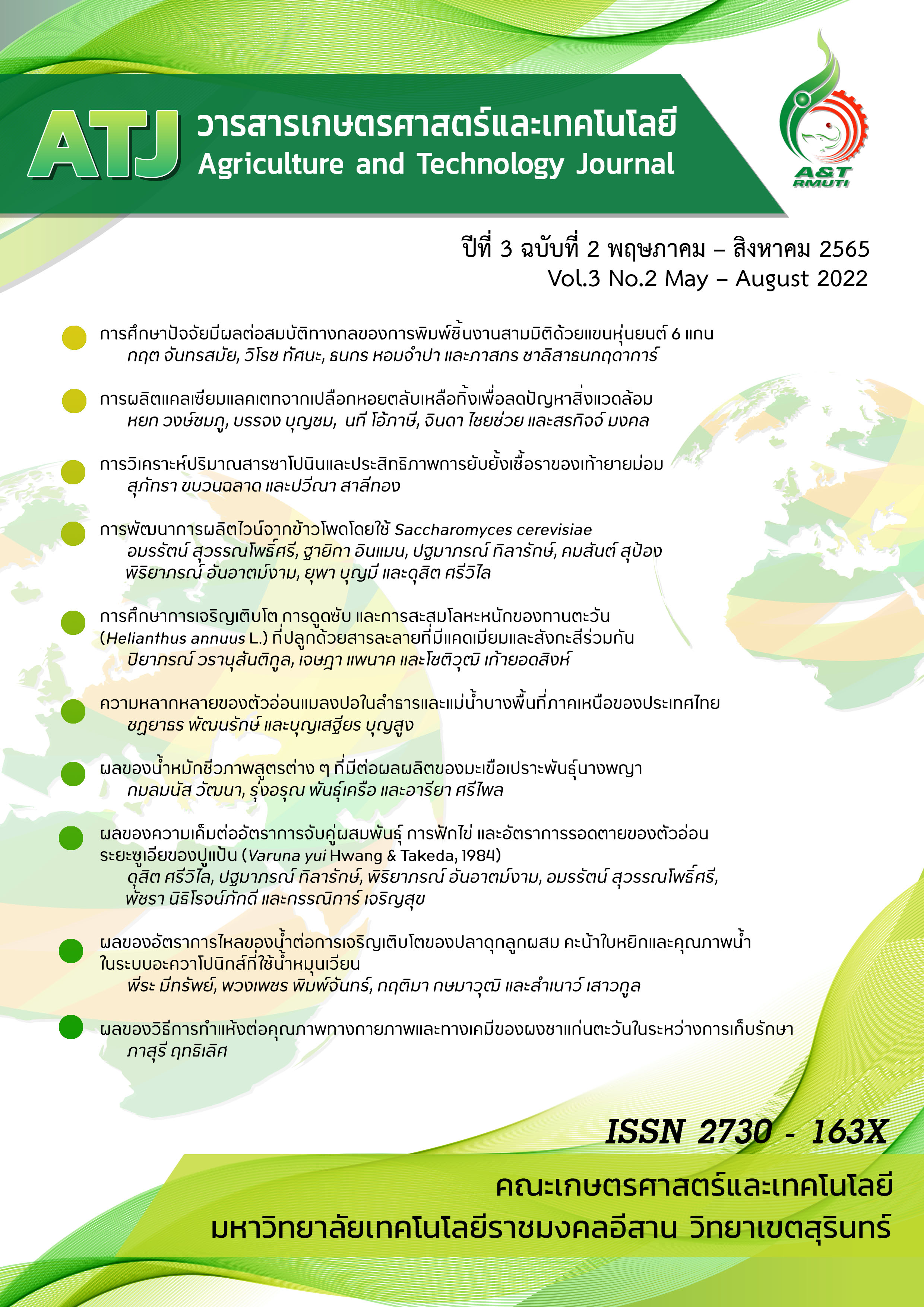Effect of water flow rates on growth of hybrid catfish (Clarias macrocephalus x C. gariepinus ), Curl leaf kale (Brassica oleracea Acephala) and water quality parameters in aquaponic recirculating system
Effect of water flow rates on growth of hybrid catfish (Clarias macrocephalus x C. gariepinus ), Curl leaf kale (Brassica oleracea Acephala) and water quality parameters in aquaponic recirculating system
Keywords:
Aquaponic system, Ethnobotany, Curl leaf kale, Waterflow rate, Nutrient removalAbstract
This study aims to investigate effects of water flow rate in an aquaponics system on growths of hybrid catfish and Curl leaf kale (Brassica oleracea Acephala), water quality and efficiency in nutrient removal. There were three different flow rates including 2000 (T1), 2,400 (T2) and 2,700 (T3) liters per hour, according to the completely randomized experimental design of which individual treatments having 3 replicates. The fish culture system consisted of a 1,000 liter tank containing hybrid catfish with an average weight of 100 g, as well as a stocking of 100 fish/m2. The kale was seedlings cultivated, and thereafter was transferred to the 1×5×0.20 m3 aquaponics system, having 50 kale plants per experimental set. Growth rate, productivity of the fish and the kale, as well as changes in water quality were assessed at the end of the 90 day trial period. Experimental results showed that the growth rates of the hybrid catfish statistically were significant differences (p<0.05) among all experimental groups. The rates were increased in respects to increases of the water flow rates. The highest mean value of the fish weight was found in T3 (276.54±2.14 g), meanwhile the values of T2 and T3 were 247.11±1.91 g, and 200.50±1.05 g, respectively. The highest fish survival rate was observed in T3 (99.67± 0.58%), followed by T2 (86.00±2.00%), and T1 80.33±1.52%). The highest net yield (kg/m3) was T3 (27.56±0.37), followed by T2 (21.25±0.38). and the lowest value was in T1 (17.71±0.31), respectively. The yields of kale were statistically different. The highest fresh weight yield was found in the flow rate of T1 (185.81±3.90 kg), followed by T2 (185.81±3.90 kg) and T3 (130.50±4.16 kg), respectively. The dry weight yields also were decreased accordingly. This aquaponics system can significantly reduce wastewater pollutions from hybrid catfish cultures. The removal efficiencies of BOD5, TSS, TAN, NO2-N, NO3-N and TP were in the following ranges: 44.88–53.51%, 65.04-67.15%,72.25–85.60%, 65.51-77.19%., 65.82-74.77% and 53.68–54.72%, respectively. The best pollution treatment efficiency was occurred at the highest flow rate i.e., 2,700 liters/hour.
Downloads
Published
Versions
- 2024-02-19 (3)
- 2023-05-29 (2)
- 2022-08-30 (1)
How to Cite
Issue
Section
License
Copyright (c) 2022 Agriculture and Technology Journal

This work is licensed under a Creative Commons Attribution-NonCommercial-NoDerivatives 4.0 International License.
เนื้อหาและข้อมูลในบทความที่ลงตีพิมพ์ในวารสารทดสอบระบบ ThaiJo2 ถือเป็นข้อคิดเห็นและความรับผิดชอบของผู้เขียนบทความโดยตรงซึ่งกองบรรณาธิการวารสาร ไม่จำเป็นต้องเห็นด้วย หรือร่วมรับผิดชอบใดๆ
บทความ ข้อมูล เนื่อหา รูปภาพ ฯลฯ ที่ได้รับการดีพิมพ์ในวารสารทดสอบระบบ ThaiJo2 ถือเป็นลิขสิทธิ์ของวารสารทดสอบระบบ ThaiJo2 หากบุคคลหรือหน่วยงานใดต้องการนำทั้งหมดหรือส่วนหนึ่งส่วนใดไปเผยแพร่หรือเพื่อกระทำการใดๆ จะต้องได้รับอนุญาตเป็นลายลักอักษรณ์จากวารสารทดสอบระบบ ThaiJo2 ก่อนเท่านั้น






